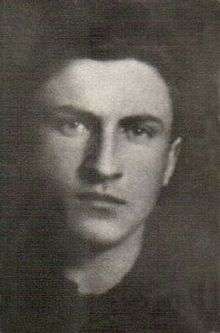Ion Gavrilă Ogoranu

Ion Gavrilă Ogoranu (January 1, 1923 – May 1, 2006) was a member of the fascist paramilitary organization The Iron Guard, who between 1948 and 1956, after the Soviet occupation of Romania, became the leader of an armed anti-communist resistance group in the Făgăraş Mountains.
Biography
Ion Gavrilă Ogoranu was born in a Romanian family as one of three children, in Țara Făgărașului. He studied at "Radu Negru" high school in Făgăraș, where he was a member of the Frăția de Cruce "Negoiu" (The Brotherhood of the Cross), the youth wing of The Iron Guard. He attended classes at the Department of Agronomy, University of Cluj. Between 1941 and 1944, he was imprisoned for "forbidden activities". He was involved in anti-communist activities in Cluj. For 7 years (1948 - 1955), he led the Grupul Carpatin Făgărășan. For his activities he was sentenced in absentia to 19 years in prison and, later, in 1951, to death. For 29 years, the Securitate were unable to capture him. He was caught in 1976, after 21 years on the run, at the house of the widow of a political prisoner, Ana Săbăduș, who later became his wife. He was reportedly spared execution at the direct intervention of U.S. President Richard Nixon.[1]
Legacy
His life is the subject of a movie, Portrait of the Fighter as a Young Man. At the 60th Berlin International Film Festival, the movie attracted protests from organizations such as the Elie Wiesel National Institute for Studying the Holocaust in Romania,[2] which demanded that the film be pulled.[3] The Festival refused to pull it, arguing that they don't believe in censorship, but they are aware that Ogoranu made publicly "extremist, racist, and antidemocratic statements" and that they do not support such views, and neither does the movie.[3]
References
- ↑ "Filmul despre Gavrilă Ogoranu provoacă proteste la Berlin", Evenimentul Zilei, February 16, 2010
- ↑ William Totok, Portretul luptătorului la tinereţe (Film von Constantin Popescu, 2010), in: Handbuch des Antisemitismus. Judenfeindschaft in Geschichte und Gegenwart, Literatur, Film, Theater und Kunst, Bd. 7, herausgegeben von Wolfgang Benz, De Gruyter Saur, Berlin / München / Boston 2014, p. 390-391.
- 1 2 "Protests from Holocaust Institute: Berlinale Resists Call to Pull Romanian Film", Spiegel, February 17, 2010